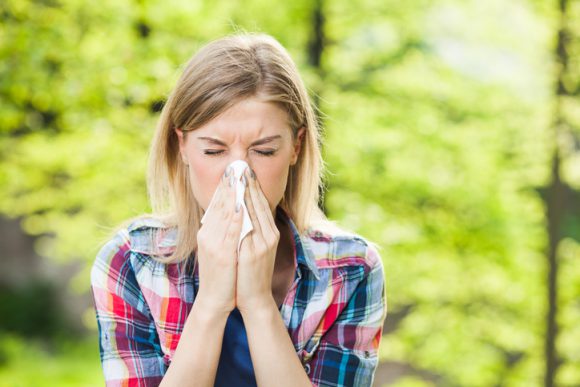
As outdoor activities in the spring increased, more people complained of nose-related respiratory symptoms.
In the spring, foreign substances in the air that threaten the respiratory health are unfolding. Typical unwelcome guests in spring include pollen allergy, spring cold, and pet molting.
◆’Pollen allergy’ came with spring flowers = Pollen allergy is an allergic respiratory disease, caused by inhaling the powder of hydrangea through the nose or airways. Representative symptoms include allergic rhinitis, conjunctivitis, dermatitis, and bronchial asthma. In particular, when allergic rhinitis occurs, a runny nose such as water continues to flow, sneezes continuously, and both nostrils are alternately blocked. To prevent this, it is better to refrain from outdoor activities from 10 a.m. to 2 p.m., when the number of spores is the most, and to exercise outside in the late afternoon or evening. When you return home after going out, you need to wash clothes exposed to pollen and take a shower.
◆’Spring cold’ that comes when the days are hot and the nights are chilly = During the changing season, you can catch the spring cold. Colds mainly occur in winter, when indoor life increases and the likelihood of contact with infected people increases, but these days, corona 19 reduces outdoor activities, so caution is also required during the changing seasons. The most common cause of colds and runny nose colds (acute rhinitis) is rhinovirus, and the number of people with colds caused by rhinoviruses rapidly increases in spring and autumn. The rhinovirus travels through the hands to the mucous membrane of the nose or eyes, causing transmission. Therefore, it is important to wash your hands often and not touch your nose or eyes.
◆ Repeated’pet moulting’ at this time of year = Dogs and cats, which are typical companion animals, fall out the most in spring. This is because it is the moulting time when the thick hairs that have covered the body are shed to spend the warm winter. Animal hair is one of the major antigens of allergic rhinitis. Allergic rhinitis is not a life-threatening disease, but it degrades the quality of life, interferes with academic and social life, and can worsen by asthma or sinusitis, so appropriate treatment and environmental and physical cleanliness management are required.
◆ How to keep my nose healthy in spring?= The nose acts as an air purification device that protects our body from foreign substances. The cilia of the epithelium in the nasal mucosa carry small dust and bacteria contained in the mucous layer to the pharynx. Purification and humidification are achieved through these mucous cilia movements.
To promote these ciliary movements, there is a method of nasal washing (nasal washing). A nose rinse helps to remove debris from the mucous layer and maintain humidity, and also helps reduce swelling by removing inflammatory mediators.
When washing the nose, you can use a high-concentration saline solution with a high sodium chloride concentration, such as Handok’s Pes (Pes Natural Nasal Spray). It is a high-concentration saline solution of 3% similar to natural seawater, which causes osmotic pressure to reduce swelling in the nose and helps relieve nasal congestion. This hypertonic spray product is an over-the-counter drug that can be easily purchased at a pharmacy, and can be used every day without a time limit, making it easy to manage your nose cleansing routinely.
Professor Kim Byeong-guk of the Department of Otorhinolaryngology, Eunpyeong St. Mary’s Hospital, Catholic University said, “Spring is a season with many threats to the health of the nose.”
“Patients suffering from chronic nasal symptoms or patients with recurrent nasal symptoms should receive internal and surgical treatment appropriate for the disease. There is” he said.
Reporter Moon Se-young [email protected]
Copyrightⓒ’Honest Knowledge for Health’ Comedy.com (http://kormedi.com) / Unauthorized reproduction-redistribution prohibited
